Differences in
passing
the head variable
in
C and
Java
- Due to the
fact that
Java is an
Object Oriented
programming language:
- The
head variable
is
stored
inside the
List class
- List manipulation
methods
access this variable as:
this.head
|
Example:
public class List
{
private Node head;
public void insert( ... ) { this.head... }
public void remove( ... ) { this.head... }
...
}
|
- The
head variable is
passed to
the methods as
the
implicit
parameter:
List myList = new List();
myList.insert( ... ); // Uses myList.head as: this.head
|
|
Differences in
passing
the head variable
in
C and
Java
- Due to the
fact that
C is
not
an
Object Oriented
programming language:
- The
head variable
and the
(insert/remove) methods that
manipulate the
linked list are
stored
separately
- We
must
pass
the
head variable
as a
parameter
to the
list manipulation functions
(It will be
passed
by value !)
-
Therefore,
the list manipulation functions
must
return the
new
head value
(so we can
update the
head variable
|
Example:
|
Differences in
passing
the head variable
in
C and
Java
Differences in
passing
the head variable
in
C and
Java
Differences in
passing
the head variable
in
C and
Java
List processing algorithms
- Recall that:
- The program
uses the
first
(or
head)
variable to
reference to the
first node of
a linked list
-
Only the
first node is
immediately
accessible by
the program
|
-
Processing
data stored in
a linked list
(a.k.a. list processing)
often requires:
-
visiting
all
elements in the
linked list by
traversing the
chain
|
Graphically:
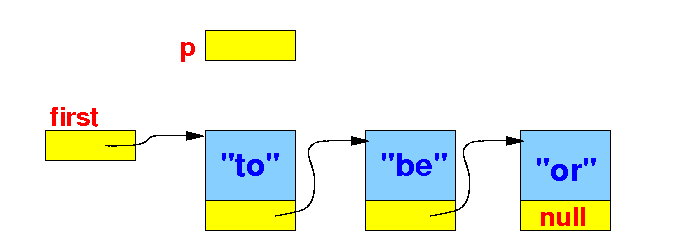
|
The standard list traversal algorithm
- Warning:
you must
never use
the variable
first
to traverse
the linked list:
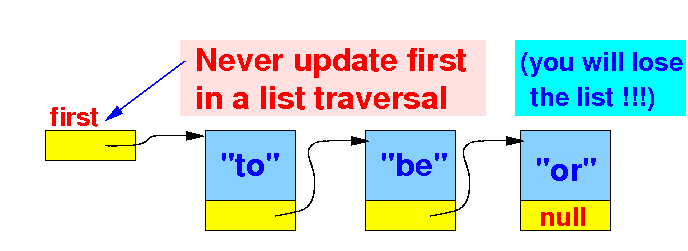
// The standard list traversal algorithm
Node p;
p = first;
while ( p != NULL )
{
// Process data in node p
p = p->next;
}
|
|
The standard list traversal algorithm
- Define a
helper reference
variable p
to traverse the
linked list:
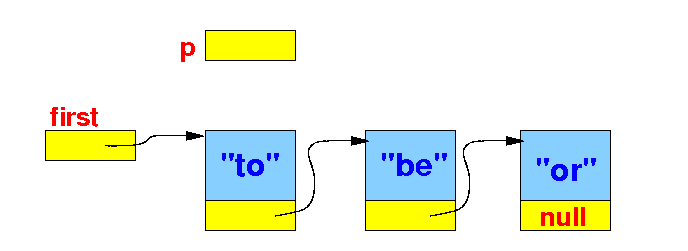
// The standard list traversal algorithm
struct Node *p;
p = first;
while ( p != NULL )
{
// Process data in node p
p = p->next;
}
|
|
The standard list traversal algorithm
- Initialize the
helper reference
variable p
to point the
first node of the
linked list:
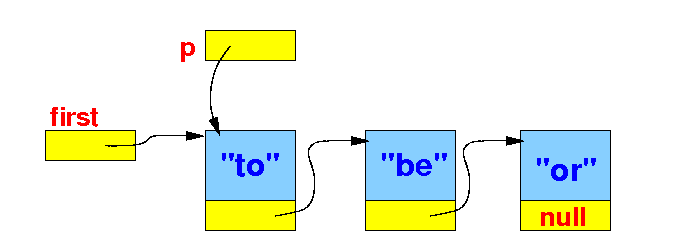
// The standard list traversal algorithm
struct Node *p;
p = first; // P now points to the first node
while ( p != NULL )
{
// Process data in node p
p = p->next;
}
|
|
The standard list traversal algorithm
- When p
is pointing at a
certain node, we can
access its
data as
p->item:
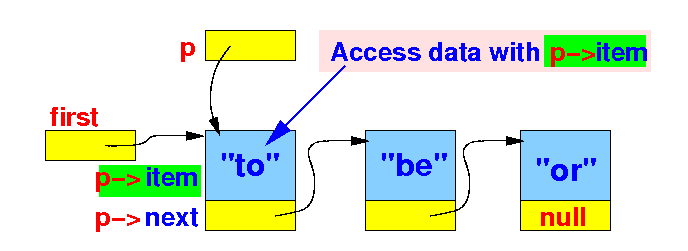
// The standard list traversal algorithm
struct Node *p;
p = first; // P now points to the first node
while ( p != NULL )
{
Notice: p->item/value is the data stored in node
Notice: p->next is the address of the next Node !
}
|
|
The standard list traversal algorithm
- After processing a
node, we
advance
p to point to
the next node with the
statement
p =
p->next:
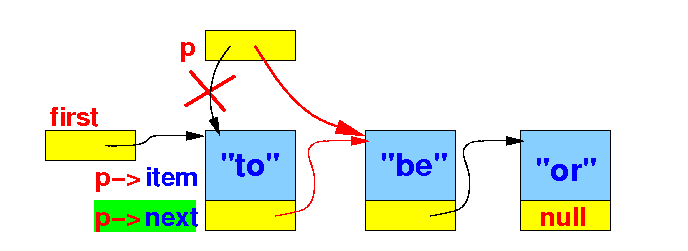
// The standard list traversal algorithm
struct Node *p;
p = first; // P now points to the first node
while ( p != NULL )
{
p = p->next; // Advances p to next node
}
|
|
The standard list traversal algorithm
-
Insight:
the reason
why
the variable p
"advances" to the
next node is because
p = p->next
assigns
the address in
p->next
to the variable
p:
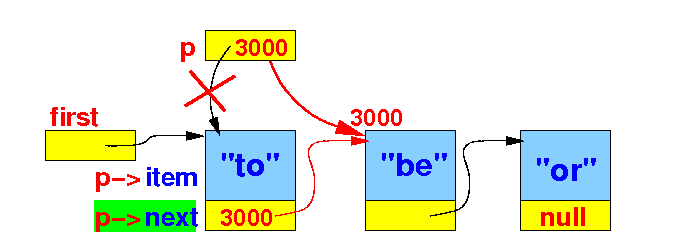
// The standard list traversal algorithm
struct Node *p;
p = first; // P now points to the first node
while ( p != NULL )
{
p = p->next; // Advances p to next node
}
|
|
The standard list traversal algorithm
- We repeat the
steps until
we have process the
data in the
last node, then
p will contain
NULL:
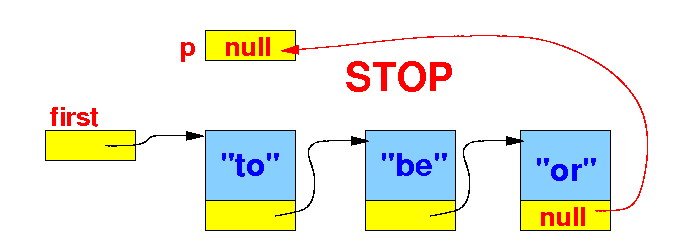
// The standard list traversal algorithm
struct Node *p;
p = first; // P now points to the first node
while ( p != NULL )
{
// Process data (p->item/value) in node p
p = p->next; // Advances p to next node
}
|
|
Animation of
the standard list traversal algorithm
Use the list traversal algorithm
to
print out all items in a list
- Problem:
write a
program fragment that
-
Print out
all the
item values
stored
in a linked list
|
- The list traversal
algorithm
will visit
every node
p:
// The standard list traversal algorithm
struct Node *p;
p = first; // P now points to the first node
while ( p != NULL )
{
// Visiting node p (p->item = data store in p)
p = p->next; // Advances p to next node
}
|
|
Use the list traversal algorithm
to
print out all items in a list
DEMO:
demo/C/Linked-list/traverse.c
Enhancements of the
list traversal algorithm
- The list traversal
algorithm is the
basis for
other
list processing
algorithms.
Example:
- Find a
node in the
list
that contains a special value
(say: X).
|
- Here is the
basic
list traversal
algorithm:
struct Node *current = first;
while ( current != NULL )
{
// Process current node here
current = current->next; // Move to next node
}
|
|
Enhancements of the
list traversal algorithm
- The list traversal
algorithm is the
basis for
other
list processing
algorithms.
Example:
- Find a
node in the
list
that contains a special value
(say: X).
|
- To find a
node that contains
X, we
exit the
loop when
the current contains
the X:
struct Node *current = first;
while ( current != NULL ) // Find list element containing X
{
if ( current (node) contains X )
break;
current = current->next; // Move to next node
}
// Here:
// either current == NULL (no node contains X)
// or the current (node) contains X
|
|
Enhancements of the
list traversal algorithm
- The list traversal
algorithm is the
basis for
other
list processing
algorithms.
Example:
- Find a
node in the
list
that contains a special value
(say: X).
|
- The search adaptation
of the list traversal
is
often
written
as follows:
struct Node *current = first;
while ( current != NULL && !(current (node) contains X) )
{
current = current->next; // Move to next node
}
// Here:
// either current == NULL (no node contains X)
// or the current (node) contains X
|
|
Use the list traversal algorithm
to
find a list element
that contains a certain key
- Problem:
- Write a method that
returns
a list element that
contains a certain value
|
- The method
findNode(f, s)
finds a node in
linked list f that
contains
the value s:
struct Node *findNode( struct Node *f, int s )
{
struct Node *p = first;
while ( p != NULL )
{
// Visiting node p (p->item = data store in p)
p = p->next; // Advances p to next node
}
return NULL;
}
|
|
Use the list traversal algorithm
to
find a list element
that contains a certain key
- Problem:
- Write a method that
returns
a list element that
contains a certain value
|
- We test
every node
by (1)
visit the
node (using the variable
p):
struct Node *findNode( struct Node *f, int s )
{
struct Node *p = f; // Start at the first node f
while ( p != NULL ) // Visit every node in list f
{
// Visiting node p (p->item = data store in p)
p = p->next; // Advances p to next node
}
return NULL;
}
|
|
Use the list traversal algorithm
to
find a list element
that contains a certain key
- Problem:
- Write a method that
returns
a list element that
contains a certain value
|
- (2) If
node p
contains the
search value,
we return
p:
struct Node *findNode( struct Node *f, int s )
{
struct Node *p = f; // Start at the first node f
while ( p != NULL ) // Visit every node in list f
{
if ( p->item == s )
return p; // Found s --> return p
p = p->next; // Advances p to next node
}
What to do if not found???
}
|
|
Use the list traversal algorithm
to
find a list element
that contains a certain key
- Problem:
- Write a method that
returns
a list element that
contains a certain value
|
- (3) If
we
exit the
loop, then
s is
not found in the
linked list f ---
we
return
NULL:
struct Node *findNode( struct Node *f, int s )
{
struct Node *p = f; // Start at the first node f
while ( p != NULL ) // Visit every node in list f
{
if ( p->item == s )
return p; // Found s --> return p
p = p->next; // Advances p to next node
}
return NULL; // Not found
}
|
|
DEMO:
demo/C/Linked-list/findNode.c
❮
❯